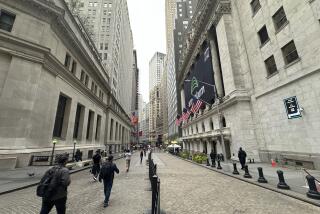Markets Drop Worldwide; Dow Off 79
- Share via
NEW YORK — Russia’s worsening financial crisis sent stock markets plunging worldwide on Wednesday, but the sell-off was blunted on Wall Street, where a late-afternoon rebound by some blue-chip stocks limited the damage.
Bond prices and the dollar rose as investors were unnerved by the potential for a collapse of Russia’s financial system.
Commodity prices plunged to their lowest levels in about a decade as the contagion of low demand continued to spread from Asia to the economies of the world’s richer nations.
The Dow Jones industrial average, which had dropped as many as 135 points in the first hour of trading, finished down 79.30 points, or 0.92%, at 8,523.35, erasing the two previous days’ gains. The Standard & Poor’s 500-stock index also held its losses to under 1%, falling 8.66 to 1,084.19.
Stocks climbed back from their lows after Stanley Druckenmiller, chief investment officer of George Soros’ $22-billion group of funds, told CNBC that the U.S. stock market is now the world’s most attractive and predicted that money will pour into U.S. assets because of the turmoil in overseas markets.
He said the U.S. Federal Reserve is now more likely to ease interest rates than to raise them.
Druckenmiller also disclosed that investors in the Soros funds have lost $2 billion in Russia in the last year, making them among the hardest hit of the investors affected by the upheaval there.
Small stocks fared much worse than the blue chips, continuing a pattern that developed last spring. The Russell 2,000 index of smaller stocks dropped 9.35 points, or 2.4%, to 380.41, marking its sixth straight decline and leaving it off 22.6% from its April 21 high. The Nasdaq composite index fell 30.04 points, or 1.67%, to 1,768.13.
“At this point, money managers are staying exclusively with safe-haven names,” said James Herrick, managing director of equity trading at Robert W. Baird.
Declining issues easily topped advances once again on the New York Stock Exchange, 2,767 to 697, with 674 million shares changing hands, above the daily average of 638 million for the last three months. Just seven stocks set new highs while 683 hit new lows.
But compared with the carnage in Europe and Latin America on Wednesday, Wall Street looked good.
After news that the Russian government had all but given up trying to defend its currency--the ruble--against its slide, Russia’s benchmark RTS stock index tumbled 10.44%.
Finger-pointing, which started Sunday when President Boris N. Yeltsin dismissed the 4-month-old government of Prime Minister Sergei Kiriyenko, intensified. After the ruble’s 5% plunge Wednesday, acting Prime Minister Viktor S. Chernomyrdin said he was “extremely unhappy” with the central bank and would meet later with Bank of Russia Chairman Sergei Dubinin to express his displeasure.
The Russian crisis touched off selling across Europe. Germany’s DAX index tumbled 3%, Britain’s FTSE-100 fell 1.9%, and Spain’s IBEX 35 fell 3.6%.
Latin American markets plunged as Russian losses pushed interest rates higher on concern that currency devaluations would spread. Brazil’s Bovespa index fell 3.9%, Mexico’s Bolsa index dropped 3.4% and Argentina’s Merval index fell 2.7%.
U.S. Treasury securities continued to benefit from the turmoil, as investors sought U.S. government debt as a refuge. Shorter-term notes rallied while bond yields lingered near more than 20-year lows.
The yield on the 10-year U.S. Treasury note dropped 2 basis points to 5.21%. Two-year note yields fell 4 basis points to 5.11%. The yield on the 30-year T-bond fell to 5.42% from 5.43% on Tuesday.
The dollar climbed to the highest point in more than a week against the German mark, which is vulnerable to events in Russia because Germany is its biggest trading and lending partner.
In late New York trading, the dollar rose to 1.8066 marks from 1.7994. The dollar lost against the yen, however, slipping to 144.02 Japanese yen from 144.21.
The benchmark Commodity Research Bureau index of 17 leading commodity prices fell to a 12-year low at 197.72 points midday Wednesday, its lowest level since July 1986.
Gold prices at $282.20 an ounce Wednesday were near their lowest level in 18 years, while crude oil prices at about $13.58 a barrel were not far from the 11-year lows seen in June. Copper, corn, wheat, soybean and sugar prices were also at their lowest levels in about a decade.
Oil-field service companies’ shares fell on reduced expectations for further oil production cuts and concern that a weaker economy will lower demand for oil field products and services. The Standard & Poor’s index of oil service companies fell 5.1%, with Schlumberger dropping $2.44 to $51.81.
Bank stocks fell on growing worries about global economic weakness. NationsBank lost $1.50 to $69.13; BankAmerica fell $1.50 to $77.63, Citicorp eased $2.88 to $133.25, and Mellon Bank dropped $1.94 to $58.44.
*
Market Roundup, D7
More to Read
Inside the business of entertainment
The Wide Shot brings you news, analysis and insights on everything from streaming wars to production — and what it all means for the future.
You may occasionally receive promotional content from the Los Angeles Times.










